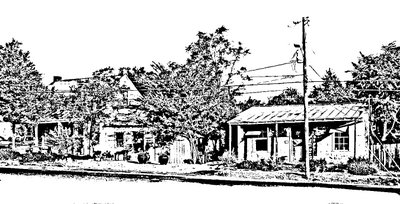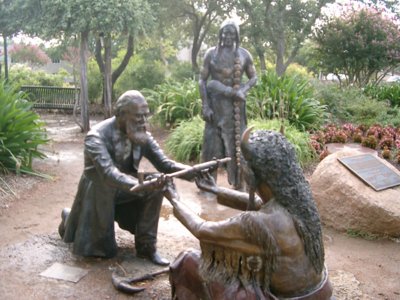I just finished Mark Gimenez' The Perk and I am confused. The book is set here in Fredericksburg, but it's not my Fredericksburg. Although some of the stores are named, the fictional Fredericksburg bears as much resemblance to the real Fredericksburg as Roger Rabbit's Los Angeles to the real City of Angels. Some long gone landmarks still exist, and some newer buildings were never built. For example, there is no public library in the book. That building, built in the 1880s, is still the courthouse. The new courthouse doesn't exist, but the tree sculpture in front of the library is there.
and I am confused. The book is set here in Fredericksburg, but it's not my Fredericksburg. Although some of the stores are named, the fictional Fredericksburg bears as much resemblance to the real Fredericksburg as Roger Rabbit's Los Angeles to the real City of Angels. Some long gone landmarks still exist, and some newer buildings were never built. For example, there is no public library in the book. That building, built in the 1880s, is still the courthouse. The new courthouse doesn't exist, but the tree sculpture in front of the library is there.
If you're a fan of Rather Sweet, sorry, it's not in the book. The building is, instead, a coffee shop downstairs and an artist's studio upstairs, and is run by some "lesbians from Austin."
This book is difficult to get. It hasn't been published in the US and I think you will see why shortly. Although, you can find some used copies on Amazon.com (clink the link above).
The first sentence reads "She was posing outside the limo with a dozen other girls, like illegal Mexicans waiting for work on L.A. street corners." Which is perfect because that's what the book is about: illegal Mexicans.
A "Perk" is, in Hollywood parlance, a perk of the job. It can be free booze, a stretch limo, or willing young girls to sleep with.
The Perk the book is titled after is Heidi Geisel. Heidi is a sixteen year old German girl. She's so eager to leave her hometown of Fredericksburg that she goes to Austin during the New Years' South By Southwest Film Festival (the first of many divergences from reality) to seduce stars to get a screen test. Her dream is cut short when she's found dead on New Years Day just outside of town.
Four years later, Beck Hardin returns to Fredericksburg. Twenty-four years ago, after his mother's death, Beck was so desperate to leave his German hometown that he accepted a Notre Dame scholarship and became a lawyer in Chicago. After his wife died of cancer, her returns to Fredericksburg to get his father's help to raise his kids. He runs for county judge, and wins because there is a particularly nasty case coming up: The star Football player who will lead Fredericksburg High to a championship assaulted a Hispanic kid. Prosecuting will end the championship run. Not prosecuting will get "the Mexicans all riled up," as one character put it.
The whole book is about this case, with the search for Heidi's killer the B plot. Which makes me wonder why it's called "The Perk"? It should have been titled "Them Damn Racist Germans" or "Them Damn Illegal Mexicans".
See, Gimenez seems to believe, or at least his Fredericksburg friends believe, that all the Hispanics in Fredericksburg, except the children (who were born here to give the illegal parents an "anchor") are illegal. And all it takes is a Federal raid to get rid of them all. They are even able to bulldoze "The Barrio," the area along South Milam Street and Live Oak street. And the book ends with a Fredericksburg with almost no Hispanics. In Gimenez' Fredericksburg, there is no Escamilla Body Shop or Morales Plumbing, and the Doctors Cantu don't have a thriving practice here because they're illegal and afraid of showing their faces on Main Street lest the city police (who never really appear in the novel, but hover Gestapo-like in the minds of the lead Hispanic character) fall upon them with batons and jack-boots. But the Germans still hire the illegals to work their fields and run their factories. What the book doesn't tell you is that the Newcomers in real life also hire workers of dubious legality to build their over-sized limestone homes, lay their limestone patios, and build their limestone fences. In the book, the local stone mason in German.
The anti-Hispanic bias is not only in Fredericksburg: the lead Hispanic character was offered a scholarship to UT so they can make sure they have enough Hispanics in the student body, even though his grades would have gotten him accepted anyway. This is Reagan era anti-Affirmative Action stuff. It's so 1990s. . .
Gimenez also believes that the Germans in Fredericksburg have formed a secret cabal to keep things the same as they have always been. While there is an element of truth to that, here it's greatly exaggerated. There's also some truth in the charge that the Newcomers moved to Fredericksburg because it's predominantly white. The Germans are the only racists in the book. It all reminds me of a Lone Ranger episode where the first sheep farmer comes into cattle country, with Beck Hardin as the Lone Ranger come to bring peace between the parties. But actual peace is achieved simply by deporting the Hispanics, which is probably why the book hasn't been published in the US. Not only that, the lesbians who run the coffee shop, who also act as the moral compass of the book, are the only ones who feel compassion towards the illegals and after all the parents are deported, go door to door in "The Barrio" to feed the kids. No. Really.
Ultimately, though, the book doesn't pay off for me. The titular plot line isn't actually resolved. The killer is never brought to justice, although he does get what's coming to him. But that all happens in the last couple of chapters.
Whatever you do, don't read this book and expect an exact depiction of Fredericksburg and it's citizens. And don't be mislead by the cover, it's not an action packed page turner, either. The cover is as accurate a portrayal of the book as the book is of Fredericksburg.
Is there racism in Fredericksburg? Sure. There's racism everywhere. Are there illegal Mexicans in Fredericksburg? Sure. It's an agricultural community, and like all agricultural communities in Texas, illegals work the ranches and fields. There aren't many white high school kids lining up to do the work (unless it's the family farm). The Perk is every Minuteman's dream: deport all the Mexicans and make Texas white again. And that makes the book feel a little. . .dirty.
Labels: Book Review













